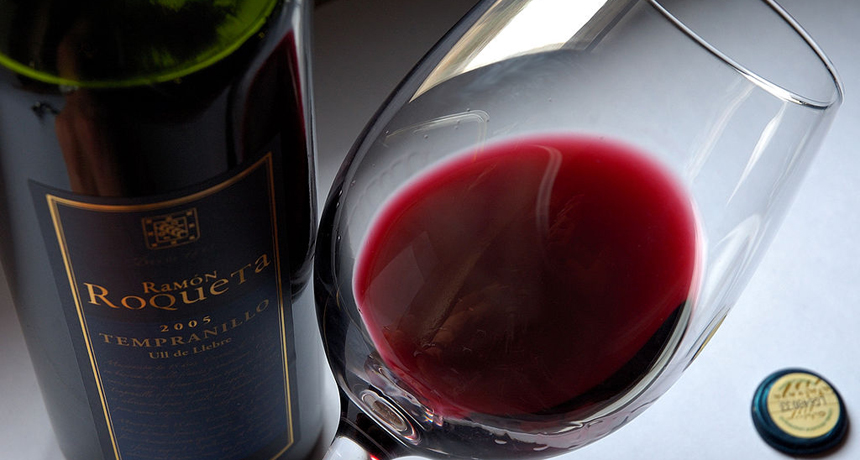Keeping wine fine for a longer time

This red wine has good legs, but time and chemical oxidation may make it less fine.
Mick Stephenson/Wikimedia Commons
- More than 2 years ago
Often, at the end of a dinner party or other festivities, someone gets picked to finish off the bottle of wine. After all, you can’t leave the last glass in the bottle! If it’s white wine, it will darken in color and won’t taste as good. Leave it for long enough and you’ll end up with something almost undrinkable.
The cause is oxidation of the trace metals present in your vintage. And a new study takes the first steps to stop that process. Bind up the trace metals with chelators, prevent the oxidation, and keep your wine fine for another time. Just in time for holiday party season.
Wine contains many naturally occurring trace metals, like iron, copper and manganese. As soon as you pop the cork on that wine, or sometimes through the pores of the cork itself, the wine and everything in it gets exposed to fresh oxygen. The oxygen reacts with some of these metals, producing a chain reaction that causes musty smells, browning and general ickiness, plaguing wine makers and wine drinkers alike. A particular culprit is iron, which is present as Fe(II) and Fe(III). Fe(II) is oxidized to Fe(III), and Fe(III) is reduced to Fe(II). At equilibrium, when Fe(II) oxidizing and Fe(III) reducing are balanced, there’s no net oxidation and all is well.
But wine is a complex mix of things like sulfites and other chemicals. These disturb the equilibrium when oxygen gets involved. In the presence of extra oxygen, more Fe(II) will be oxidized than Fe(III) can keep up with by reduction. The next thing you know your iron is oxidizing and creating peroxides in the acidic winey environment. Peroxide reacts with other metals in the wine, creating hydroxyl radicals. Those hydroxyl radicals get all up on the organic parts of the wine, causing mustiness, bad flavor and browning. Suddenly, your wine isn’t so fine.
A way to avoid this problem, of course, is the get rid of the metals. But that is costly and difficult. Not only that, the processes that take metals out of wine also strip out some of the chemicals that make your wine so fine in the first place. Another option? Use chelators, chemicals that bind up metal ions so they can no longer be oxidized or reduced. Gal Krietman and researchers from Penn State University and the University of California, Davis (in their department of Viticulture and Enology, whose existence has a certain je ne sais quois) looked at the effect of adding chelators to wine to stop oxidation.
In a paper published in the Journal of Agricultural and Food Chemistry, the researchers show that using chelators in model wine to bind up iron decreases levels of 1-HER, an intermediate chemical that results from oxidation. When the chelator ferrozine was added, it bound up Fe(II), leaving it unavailable for oxidization, and stopped the oxidation reaction from producing 1-HER. When the chelator EDTA was added to the model wine, on the other hand, it bound up Fe(III), making it unavailable for reduction. This stops it reducing back to Fe(II), so there’s less to oxidize, keeping 1-HER low. Adding chelators also lowers the levels of acetaldehyde, another product of oxidation. In theory, this means that wine with chelators present could stay less brown, less musty and more fine.
But the catch? Many chelators like ferrozine are not approved by the FDA to be used in food. Some are approved for things like getting rid of heavy metals in your system, but can have difficult side effects. For example, EDTA, one of the chemicals used in this study, binds Fe(II). But it also binds up calcium. A lot. So much so that it can cause you to suffer hypocalcemia. So your wine might be fine, but you might not be after you drink it. However, it’s possible to find other chelators that might be able to help and that are approved for use, like phytic acid.
The other catch? This is very preliminary. In fact, the whole study was done in a model wine system, which only had water, ethanol, tartaric acid, and phenolics. Not exactly your light pinot grigio or your full-bodied burgundy. Future studies will have to figure out whether chelators can keep your real wine fine. And perhaps more importantly, whether the presence of chelators helps or hurts the delicate bouquet of your chardonnay.
So, it looks like this holiday season, you’ll still have to find someone to finish off the bottle.






